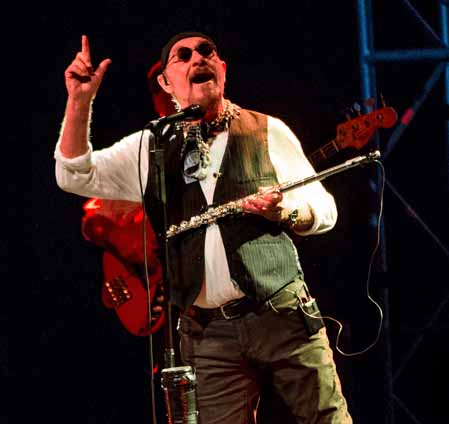It’s 2017 and Ian Anderson has once again released a record and scheduled concerts all over the world. While many of his peers have passed away, retired, or are struggling to keep their head above water, the wide-eyed singer, songwriter and flautist continually works as fervently and steadily as ever. For his latest recording, he’s taken a step back to “reimagine” a dozen Jethro Tull songs with strings and a softer, more delicate touch. It must have struck the right note because a week after it dropped, Jethro Tull: The String Quartets went to Number One…on Billboard’s Classical chart.
In the following interview, my seventh with Anderson, we talk about the origins of Jethro Tull: The String Quartets, including how it was put together, how the Carducci Quartet got involved, and the age-old question: Is this a Jethro Tull record? As always, the musician offered snappy, thought-provoking replies to each of my queries, even filling in areas I never intended to go. To parallel his work ethic, he astutely worked in a few left jabs as he explained in minute detail why a song went this way, or how it was originally played to what he “reimagined” it as.
The question of Jethro Tull received a quick reprimand, but by the end of the discourse, it all sort of made sense. You’ll have to read the interview to find out. Meanwhile, as of this posting, Anderson is preparing for dates in Europe and the U.S. that run through the end of 2017 and into 2018. With a full plate of shows and world travel, he’s also working on another record, likely a conceptual piece, although he wouldn’t say. Just keep out of the way as Ian Anderson forges ahead as a solo artist, and, with equal passion and aplomb, keeps the legacy of Jethro Tull alive and kicking.
~
How did the idea of putting Jethro Tull: The String Quartets together come about?
About a year ago, I was looking at a few projects that I had in mind, thinking what the practicalities of making a recording during the course of the year. The notion of doing an album Jethro Tull repertoire recorded with a string quartet, in a kind of classical, relatively authentic arrangement form, was something that kind of occurred, and I thought let’s see if we can make it work time-wise. And indeed, I was able to work on the arrangements with my keyboard player John O’Hara. We did have two or three things we had already done with orchestras and string quartets. It wasn’t from a standing start in every case. We worked on that, on and off, during tours, days back in the UK during the course of the year. I managed to find a string quartet I really liked, and got them booked in on the very few mutually workable days that we had in our respective diaries, and we made the recordings in the latter part of the year. We got it all wrapped up by the end of October.
To the casual listener, the arrangements may not seem all that different from the originals, but obviously you’ve worked in a few subtle elements here and there to keep it interesting. Can you talk about that?
Every song you’ve got to really treat it on its own merit. You can’t approach this like a factory production line, and arrive at a methodology and apply it in all cases. Some songs were done very literally…I mean, in the case of the remake of the song “Wond’ring Aloud,” and in the case of “A Christmas Song,” they were done very much as they were recorded originally because they amongst the very first things I ever recorded with a string quartet. They were just a remake, really. Other pieces, which we had never done in that format, were a little bit more creative…in the case of “Aqualung,” done as a fugue…in the authentic classical form of the fugue. Other pieces are recognizable once they get underway, like “Locomotive Breath,” which starts off with a long cello introduction that is something that again is trying to utilize some elements that are taken from elsewhere in the original recording.
Every song you’re just trying to come at it from a different direction, and that is what John did with the arrangements. We would talk it through, change a few things around, and arrive at the final scores, which were sent off to the string quartet so they could prepare ahead of time. They had one day of rehearsal with John. Then we recorded over a period of three days to make the record. Some of them are obviously pretty recognizable, some of them less so. And I think that’s part of the charm in that you don’t do them all in the same way.
I really like how you took “We Used To Know” and added the piano passage of Bach’s Prelude C Major to create “We Used to Bach.” Clearly, the influence of Bach is pervasive throughout this record, as it has been in much of your music.
In the case of “We Used To Know,” it was done in a different time signature, which actually borrowed from the reference to “Hotel California,” which employs the same chord sequence, albeit a different melody. Since many people have pointed out over the years the similarities of the Eagles’ “Hotel California” and the song “We Used To Know,” harmonically anyway. I thought that it would be rather fun to do a little tease. So we used the Bach feel of the “Prelude C Major” as a form for “We Used To Know,” which, of course, I put into a common time signature…which made it a little less like “We Used To Know” and a little more like “Hotel California” in places (laughs). That’s just me having a bit of fun and maybe a little playful moment.
How does recording with a string quartet differ from recording with a rock band?
There are certain places where the limitation of working on a piece where you just recreate the original recording, which, of course, is with the drums, bass, guitar and stuff. When you come to do that with a simple, very direct, very naked format of a sting quartet, then maybe you better be a bit more adventurous. Perhaps develop harmonically the process of the music arrangements, so that you maybe change keys and you of things that take it in a slightly more adventurous direction. It would be a little bit pedantic just to stay with the same thing all the way through.
Pieces like So “Locomotive Breath” and “Living In The Past,” they do undergo some changes as they work through the song, as we work though the arrangements of the string quartet, you find yourself in different keys, which is fine for me. I just had to learn the very specific arrangements when it came to adding my flute, which I did in my own studio rather than be taking up precious time in Worcester Cathedral where we only had a 12-hour lockout to work on one day, and then a historic church, where we recorded the other two days. We concentrated on getting the string quartet parts done in those rather more spiritually significant, acoustic environments.
Which piece was the most challenging?
Well, probably from John O’Hara’s perspective, I would think probably the “Aquafugue” because that required rather some more skillful writing and thought process to go into it. It was challenging, perhaps for him. Not necessarily so challenging for the string quartet or challenging for me, but for him, it was. Perhaps things that were more challenging for the string quartet were the Songs From The Wood and Heavy Horses medley. That’s actually been around for a while as an arrangement for string quartet. I think we first did that with the Skampa Quartet in Prague, about seven or eight years ago (Editor’s Note: December 16, 2009). That is quite tricky to play, that is quite a demanding piece for the musicians. So it depends…some things are not so difficult for one person, and a bit tougher for the other…but that’s music.
I would imagine working with a string quartet is much easier than a full orchestra.
Sonically easier because you’re using fewer mics and it is, of course, live. You can’t really overdub those individual instruments. If someone makes a mistake, then you start again because the leak between the instruments. They’re all so very close together, so that they have the intimacy of performing together, where they feel each other’s breath and get every little visual cue from each other to play together. They’re not being conducted, they have to play, following usually the first violin. The microphones are such that if one person makes any turning glitch, then it will be heard by the other microphones since they’re all so close together. You’ve really got to try to get two or three good takes of each piece, and then start scrutinizing them for the odd little click or bump or noise or distant airplane or some truck going by in the street. Churches and cathedrals are not recording studios. Usually by very nature of the buildings, there’s a lot of noises going on all the time. You can’t really have that security. You start according, a few minutes later, suddenly you can hear an airplane and everybody’s got to stop and let it go past and then you start again. But we knew that was going to happen. That’s just the inevitability of working on a location recording.
What made you decide to use the Carducci Quartet for this record?
Well, a very pragmatic reason. They were suggested to me through the brother of one of them because they lived in the southwest of England, which wasn’t geographically a stretch. I did think of working with the Prague Skampa Quartet but they’re in Prague, and the Hungarian string quartet that I’ve worked with, but they’re in Budapest. That presented a lot more logistic problems and potentially a lot more costs involved. So finding a quartet in the southwest of England was very lucky. I then went to see them. They had a recital in St. Lukes, the rehearsal and concert venue for the London Symphony Orchestra. I was immediately very impressed by their energy, their ensemble playing, and their technical expertise. They’re youngish folks, probably 10 years out of the Royal College of Music; a very exciting and well-thought-of string quartet doing recitals and performing at festivals, not only in the UK, but elsewhere in the world. We have busy date sheets, which is one of the reasons that the prospect of going on the road and doing some concerts really just wasn’t possible. In fact, we’re trying to work out just one single day when we might go into the BBC television studios to play live one piece on a Sunday morning. I think we have one possible day in the next month, vaguely at the same place and the same time (laughs). That’s always the case with the musicians: If they’re any good, they tend to be working.
So, then you are not recreating these string quartet arrangements at any of your concerts this year?
The shows I’m dong this year, apart from one concert in Red Rocks arena in Denver with the Colorado Symphony Orchestra, all the others are essentially production rock shows, very much the best of Jethro Tull, a selection of music that isn’t necessarily the same every night or every tour, featuring video behind us. It’s what people tend to expect today. I think it f you look at the production values of concerts today, generally speaking, it’s across the spectrum, rather more advanced technically and entertainment-wise than it would have been 20 or 30 years ago.
We’re no strangers to production and theatrical elements in our concerts, going back as far as 1972 with Thick As A Brick. We have a bit of background in it, though it’s not something we do every tour or every performance, but it’s a relatively, intellectually and artistically, an easy thing to do. Technologically, of course, it presents a lot of challenges, especially when you’re on tour, traveling around and we have to carry a couple video servers and a lot of technology with us to make this things work. Every night is a different show and a different city. On Monday, I fly to Kiev in the Ukraine and then we play a show there. And the next day, we fly to Vilnius in Lithuania and we have to set up again for a show the next night after a considerable journey. Everything’s got to work, everything’s got to be like clockwork when you’re on tour.
You’ve issued this new record under the Jethro Tull name. Is this a Jethro Tull record?
I will leave it to you to figure it out. I’ve tried to suggest to people over the last two or three years that Jethro Tull for me, is three things. First of all, he was a historical character whose name our agent purloined, and I am guilty for 49 years of identity theft as a result of that. The second thing that it means is the 32 members of Jethro Tull, if you take the broad definition of people who have played a number of tours or performed on records with Jethro Tull, making up the members of the band, a lot of people. And the third thing that it means, and perhaps the most important thing from a musical standpoint for me, it’s the repertoire, it’s the music of Jethro Tull.
When we say, if we say, “Oh I love Beethoven.” We don’t mean we like this rather sort of 56-year-old man who was struggling with deafness and beginning to work on his 10th symphony when he died. We don’t really know that much about him. From a personal standpoint, we don’t know very much about most of the great classical composers. What we mean when we say we love Beethoven is that we love the music of Beethoven. And I think you can extrapolate that also to cover more recent music. We say, “I love the Beatles.” Then you don’t mean you love John, Paul and whatever the other two guys were called, you mean you love the music. Maybe you mean you just love Sgt. Pepper. You’re talking repertoire. That seems to me, when you’re looking at the big picture, and of course, in the case of the Beatles, there are two of them still alive and still performing, from time to time. When we talk about that, we talk about the repertoire. I think that’s what we really mean, rather than necessarily the individuals.
Of course, in the case of Jethro Tull, I am the founding member who’s the continuity, and also the person who’s written the music and been the producer and the organizer of things, and general factotum during all that period of time. Perhaps, in a way, you have to think of me as being a band leader, maybe in the tradition of Frank Zappa or John Mayall or the rather dubious James Brown, or the terribly nice BB King. There are band leaders who are good guys and some who are absolute dictators and scary people. Frank Zappa was a good guy. They loved him. Everyone who worked for him, just thought this was the most wonderful experience and a great opportunity to be in his band for a few months, or a year or two, whatever it might have been. You won’t find anyone badmouthing Frank Zappa, but you’ll find the members of Captain Beefheart’s Magic Band are much less kind about his tyranny (laughs). I think you’ll find the same thing about James Brown’s musicians, whereas the guys that played with BB King, least those I ever heard from, have said what a great guy he was to work with.
Band leaders are rather like dictators of small countries. They tend to come in different colors and wear different hats. Where I sit in that pantheon of greatness or disgracefulness, depending on your point of view, I have to leave it to others to decide. I’m the point of continuity. People were saying at the time of Living With The Past album in 1971 that just featured a graphic of me on the front cover. That was something that I guess continued on others albums like War Child, for example. What you saw was a motif of a flute player standing on one leg or whatever or a picture of me. People would get the impression that Jethro Tull is Ian Anderson. Or they would even think my name was Mr. Tull. We’ve had that duality all through these years. I think out of respect to the 32 other guys, some of whom, sadly, are no longer with us, some of whom are not feeling terribly well at the moment, and many of whom no longer play music and haven’t done for many years. I like the idea of paying respect of saying this is kind of historic picture, as laid out in the repertoire that we worked on during all those many lineups. So, whether you think of me of a solo artist in a post-Jethro Tull era, whether you think of Jethro Tull having this continuity where it goes on. We think of the repertoire rather than a particular group of musicians. That’s really up to you to figure out. It’s not something I really think about. I haven’t been thinking about it for the past 30 years.
Are there plans for more Steven Wilson Jethro Tull reissues? I would assume Songs From The Wood would be next.
Yeah, we’re just wrapping up. All the music is done and all the video stuff is done. There’s a couple of live concerts — one video concert and one live audio concert, based on the Songs From The Wood repertoire at the time, 1977. That’s been done actually for a few months. The last time I went to see Steven Wilson was some time towards the end of last year, and we went through the 5.1 surround mixes in December. So that’s wrapped up apart from the last couple of points of remembrance on the album artwork.
I don’t expect him (Wilson) to keep doing this forever because we’ll run out of the era at which Jethro Tull for him, as a young man growing up, was one of those bands that I suppose was something of an influence, and of which he was a bit of a fan. But when you get to the point where you start performing music yourself, you tend to start thinking about your own stuff rather than listening to other people. So I think Steven has it in mind that he would do the stuff from the beginning toward to the end of the 70s, and then we’ll take a view on what comes next after that.
Any plans for another Ian Anderson studio album?
I should have actually managed to record six new tracks during the course of February, but unfortunately my guitar player was taken ill with a surprise ailment and we had to cancel those sessions. Which is just as well because then a few days later, I came down with a horrible chest infection of bronchitis, from which I’m only recovering now. It is now rescheduled for the middle of March .We go into rehearsals for a few days, then recording for a few days to do the first six tracks for a new album project for a 2018 release. During the course of the rest of the year, the really odd day here and there, we’ll go in and do other bits and bobs. The first chunk of it will be under our belt before we go to the U.S. in May.




















